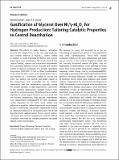Files in this item
Gasification of glycerol over Ni/γ-Al2O3 for hydrogen production : tailoring catalytic properties to control deactivation
Item metadata
| dc.contributor.author | Umar, Ahmed | |
| dc.contributor.author | Irvine, John T.S. | |
| dc.date.accessioned | 2021-01-25T12:30:08Z | |
| dc.date.available | 2021-01-25T12:30:08Z | |
| dc.date.issued | 2020-11-06 | |
| dc.identifier.citation | Umar , A & Irvine , J T S 2020 , ' Gasification of glycerol over Ni/γ-Al 2 O 3 for hydrogen production : tailoring catalytic properties to control deactivation ' , Catalysis for Sustainable Energy , vol. 7 , no. 1 , pp. 65-74 . https://doi.org/10.1515/cse-2020-0006 | en |
| dc.identifier.issn | 2084-6819 | |
| dc.identifier.other | PURE: 272471881 | |
| dc.identifier.other | PURE UUID: 07b47942-d174-49c4-8ad0-0cd05c4d86a2 | |
| dc.identifier.other | Jisc: e4ff57f080a34beca84806db403ceb9a | |
| dc.identifier.other | ORCID: /0000-0002-8394-3359/work/87403906 | |
| dc.identifier.uri | https://hdl.handle.net/10023/21314 | |
| dc.description | Authors thank the Petroleum Technology Development Fund (PTDF), Nigeria for funding this research and the University of St Andrews, Scotland UK for the consideration to work with them and to use their facilities. | en |
| dc.description.abstract | The effects of catalyst loading, calcination and reaction temperatures on the structural properties and catalytic behavior of Ni/γ-Al2O3 catalyst system in relation to steam reforming of glycerol and catalyst deactivation were investigated. The results showed that catalyst loading, reaction and calcination temperatures had a profound influence on the structure and catalytic activity in glycerol conversion. Use of high calcination temperature (900-1000 °C) led to phase transformation of the active Ni/Al2O3 to less active spinel specie NiAl2O4 that resulted in a successive change of texture and color. The particle size growth and phase change at this temperature were responsible for the catalyst deactivation and low performance especially among the catalyst calcined at high temperatures. Conversely, at low reaction temperatures, catalyst surfaces were marred by carbon deposition. Whilethe polymeric carbon deposited at metal-support interface was associated with low reaction temperatures, high reaction temperatures were characterized predominantly by both amorphous carbon deposited on the active metal surface and polymeric or graphitic carbon deposited at metal-support interface respectively. Calcination temperature showed no significant influence on the location and type of coke deposited on the catalyst surface. Hence, catalyst loading, calcination and reaction temperatures could be tailored to enhance structural and catalytic properties and guard against catalyst deactivation. | |
| dc.format.extent | 10 | |
| dc.language.iso | eng | |
| dc.relation.ispartof | Catalysis for Sustainable Energy | en |
| dc.rights | Copyright © 2020 Ahmed Umar, John T.S. Irvine, published by De Gruyter. This work is licensed under the Creative Commons Attribution alone 4.0 License. | en |
| dc.subject | Steam reforming | en |
| dc.subject | Biomass feedstock | en |
| dc.subject | Gaseous biofuel | en |
| dc.subject | Supported catalyst | en |
| dc.subject | Fuel cell | en |
| dc.subject | Coking | en |
| dc.subject | QD Chemistry | en |
| dc.subject | NDAS | en |
| dc.subject | SDG 7 - Affordable and Clean Energy | en |
| dc.subject.lcc | QD | en |
| dc.title | Gasification of glycerol over Ni/γ-Al2O3 for hydrogen production : tailoring catalytic properties to control deactivation | en |
| dc.type | Journal article | en |
| dc.description.version | Publisher PDF | en |
| dc.contributor.institution | University of St Andrews. School of Chemistry | en |
| dc.contributor.institution | University of St Andrews. Centre for Designer Quantum Materials | en |
| dc.contributor.institution | University of St Andrews. EaSTCHEM | en |
| dc.identifier.doi | https://doi.org/10.1515/cse-2020-0006 | |
| dc.description.status | Peer reviewed | en |
This item appears in the following Collection(s)
Items in the St Andrews Research Repository are protected by copyright, with all rights reserved, unless otherwise indicated.

